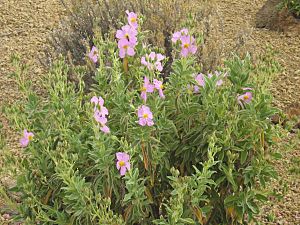Cistus osbeckiifolius facts for kids
Quick facts for kids Cistus osbeckiifolius |
|
|---|---|
 |
|
| Scientific classification |
Cistus osbeckiifolius is a type of shrub with lovely pink to purple flowers. It belongs to the Cistaceae family, which includes many flowering plants.
Contents
What Does This Plant Look Like?
Cistus osbeckiifolius is a shrub that usually grows up to about 1.2 meters (4 feet) tall. Sometimes, it can even reach 1.55 meters (5 feet)!
Its leaves are narrow and shaped like a spear or oval, with three main veins. They have tiny hairs all over them.
The flowers are about 5 centimeters (2 inches) wide and have pretty pink to purple petals. Inside the flower, the part that collects pollen (the stigma) is longer than the parts that make pollen (the stamens). After the flower, it grows brown, hairy seed pods.
How This Plant Got Its Name
This plant got its official name, Cistus osbeckiifolius, in 1887. A scientist named Philip Webb found this plant in the Canary Islands between 1828 and 1830. He named it and wrote about it, but his work wasn't published until after he passed away. In 1887, another scientist, Heinrich Christ, published Webb's description. The name osbeckiifolius means "with leaves like the Osbeckia plant."
Scientists also study how plants are related to each other using their DNA. Studies show that Cistus osbeckiifolius is part of a group of Cistus species that have purple and pink flowers, especially those found only in the Canary Islands.
Where Does It Live?
Cistus osbeckiifolius is found only on Tenerife, one of the Canary Islands. It grows high up on the mountains, between 1,400 and 2,400 meters (4,600 to 7,900 feet) above sea level. You can often find it around Mount Teide, especially in an area called Las Cañadas. The weather there is usually dry and can be cool to cold.
Is It in Danger?
Cistus osbeckiifolius is considered an "endangered" plant in Spain's "Red List" of threatened plants. This means it's at risk of disappearing.
There are a few reasons why this plant is in danger:
- It grows in only a small area.
- Most groups of these plants don't have much genetic variety, which makes them weaker.
- Rabbits sometimes eat the plants.
- Fires can destroy them. In 2007, a fire completely wiped out one group of these plants.
- Human activities can also disturb their habitat.
See also
 In Spanish: Jara de las cañadas para niños
In Spanish: Jara de las cañadas para niños

